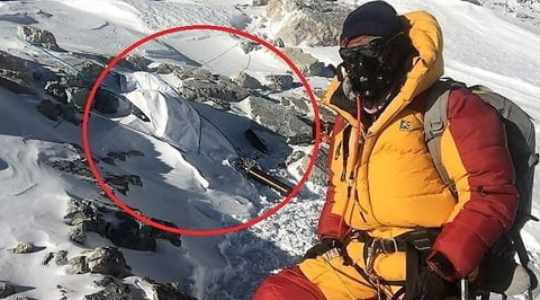
Mount Everest, the world’s highest mountain, is also infamous for being a deathbed to a chilling number of 200 people. Since 1953 when Edmund Hillary and Tenzing Norgay reached the peak of the summit for the first time, over 4,000 people have attempted the same feat, braving the harsh climate and dangerous terrain for a few moments of glory.
Some of them, however, never left the mountain. The top portion of the mountain, roughly everything above 26,000 feet, is known as the “death zone.” The climbers that survive this zone are usually left with lingering effects. However, there are others who aren’t so lucky and are left where they fall.
Standard protocol is just to leave the dead where they died, and so these corpses remain to spend eternity on the mountaintop, serving as a warning to climbers as well as gruesome mile markers.

One of the most famous corpses, known as “Green Boots” was passed by almost every climber to reach the death zone. The body of “Green Boots,” an Indian climber who died in 1996 and is believed to be Tsewang Paljor, lies near a cave that all climbers must pass on their way to the peak.
Green Boots now serves as a waypoint marker that climbers use to gauge how near they are to the summit. Green Boots met his end after becoming separated from his party. He sought refuge in a mountain overhang, but to no avail. He sat there shivering in the cold until he died. “Green Boots” is known as such because of the neon boots he was wearing when he died.

In 2006, English climber David Sharp joined Green Boots. He stopped in the now-infamous cave to rest. His body eventually froze in place, rendering him unable to move but still alive. Over 40 climbers passed by him as he sat freezing to death.
His plight might have been overlooked as passers-by assumed Sharp was the already-dead Green Boots. Eventually, some heard faint moans, realized he was still alive, and, too late, attempted to give him oxygen or help him stand.
Sharpe’s death sparked a moral debate about the culture of Everest climbers. Though many had passed by Sharp as he lay dying, and their eyewitness accounts claim he was visibly alive and in distress, no one offered their help.

Sir Edmund Hillary, the first man to ever summit the mountain, criticized the climbers who had passed by Sharp and attributed it to the mind-numbing desire to reach the top.
“If you have someone who is in great need and you are still strong and energetic, then you have a duty, really, to give all you can to get the man down and getting to the summit becomes very secondary,” he told the New Zealand Herald, after news of Sharp’s death broke.
“I think the whole attitude towards climbing Mt Everest has become rather horrifying,” he added. “The people just want to get to the top. They don’t give a damn for anybody else who may be in distress and it doesn’t impress me at all that they leave someone lying under a rock to die.”

The media termed this phenomenon “summit fever,” and it’s happened more times than most people realize.
In 1999, the oldest known body was found on Everest. George Mallory’s body was found 75 years after his 1924 death after an unusually warm spring. His body was found in 1999, his upper torso, half of his legs, and his left arm almost perfectly preserved.
He was a famous mountaineer at the time and when asked why he wanted to climb the then unconquered mountain, he famously replied: “Because it’s there.”
